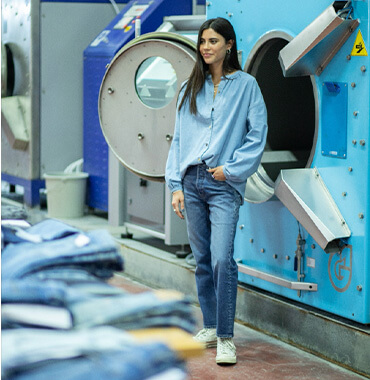Can Denim Act as a Carbon Sink?
We’re constantly trying to ‘reduce’ our carbon emissions, but what if we ‘rethought’ our approach? The concept of creating a positive climate impact when producing anything seems wildly out of reach, but we’re closer than we think thanks to carbon sequestration and carbon sinks.
We’re constantly trying to ‘reduce’ our carbon emissions, but what if we ‘rethought’ our approach? The concept of creating a positive climate impact when producing anything seems wildly out of reach, but we’re closer than we think thanks to carbon sequestration and carbon sinks. What is a carbon sink you ask? A carbon sink is any reservoir that absorbs more carbon than it releases creating a climate-positive impact or in other words, removes carbon from the atmosphere! The two most important carbon sinks are vegetation and the ocean, but since denim’s environmental scope spans across so many industries, including a heavy reliance on the agricultural industry, we have the opportunity to actually use denim for good, creating a positive impact on the planet and our people when producing it. Looking at denim’s key ingredients, cotton is a perennial favorite and an important component of any denim fabric. And thanks to our dedicated and passionate farmers around the world, there are a few different approaches to regenerative agriculture that creates “climate positive” cotton and resilient soils. Regenerative agriculture is a system of farming that can actually reverse climate change by building healthy, diverse, and mineral-rich soils, all while sequestering carbon from the atmosphere. There are at least six key approaches to increase soil carbon sequestration and so much more: integrating animals for grazing and natural fertilizers, rotating crops which allows farmers to have consistent income, building biodiversity with plantings like hedgerows and trees, conserving soil with cover cropping, boosting soil fertility with fungal-dominated compost, and methods for no-till cotton that do not depend on synthetic chemistry. Not only does regenerative farming mean more carbon storage, it increases the soil’s ability to hold water, stops soil erosion, protects the purity of our groundwater, and sets up the right conditions for crops to become more disease and pest resilient on their own. When we improve the health of our soils by growing what we need for our jeans, we’re also benefiting our own personal health. It increases the nutritional value of our food, improves the health of our planet by regenerating our soils and removing carbon from the air, and improves the livelihoods of the farmers by providing better yielding crops in the long run. Clearly the benefits are endless! According to McKinsey & Company and Global Fashion Agenda’s new report, the global apparel and footwear industry produced 2.1 billion tonnes of CO2 emissions - estimated at a daunting 4% of total global emissions. But, by switching to regenerative practices, we can doctor our soils back into their healthiest states, revive plant activity and photosynthesis, and let mother nature rebalance our out-of-whack carbon levels. Hemp has also been on the rise as a cotton alternative, and I am sure you have seen the “cotton-free” fabrics being advertised after cotton started being ridiculed for being a ‘thirsty’ crop. Industrial hemp has been scientifically proven to absorb more CO2 per hectare than any forest or commercial crop and has therefore been dubbed an ideal carbon sink! On top of this, hemp also has the ability to sequester carbon back into the soil. To put it into perspective, one ton of harvested hemp should sequester 1.62 tons of CO2, according to the British Hemp Association. Carbon capturing is going to be important for our industry going forward and if you look at all of the components that make up a pair of jeans, you can grow everything that’s needed - from the fibers to dyes, even down to the buttons. If nearly half of the carbon impact occurs within the raw material production and processing stages, using regenerative farming measures to grow denim’s ingredients will be key in using denim for carbon capture. What we need now is more support from you for “soil to skin” but those who are doing it right should be rewarded! We finally have Regenerative Organic Alliance developing a certificate for regenerative agriculture, which will gradually restore below-ground diversity. The program is currently in its pilot phase and is mainly focused on food to start, but Patagonia is a founding partner and has set a goal for all of its cotton and hemp to be regenerative-certified. Denim friends, you’re next! A climate positive jean is within reach and using regenerative farming methods is one step we can take to get there. We’re in exciting times where anything is possible while we try to ‘reset’ the system, but instead of constantly trying to think of ways to ‘reduce’ it might be time to ‘re-think’ our approach. Until next time friends.
To view full content and a better mobile experience, try



